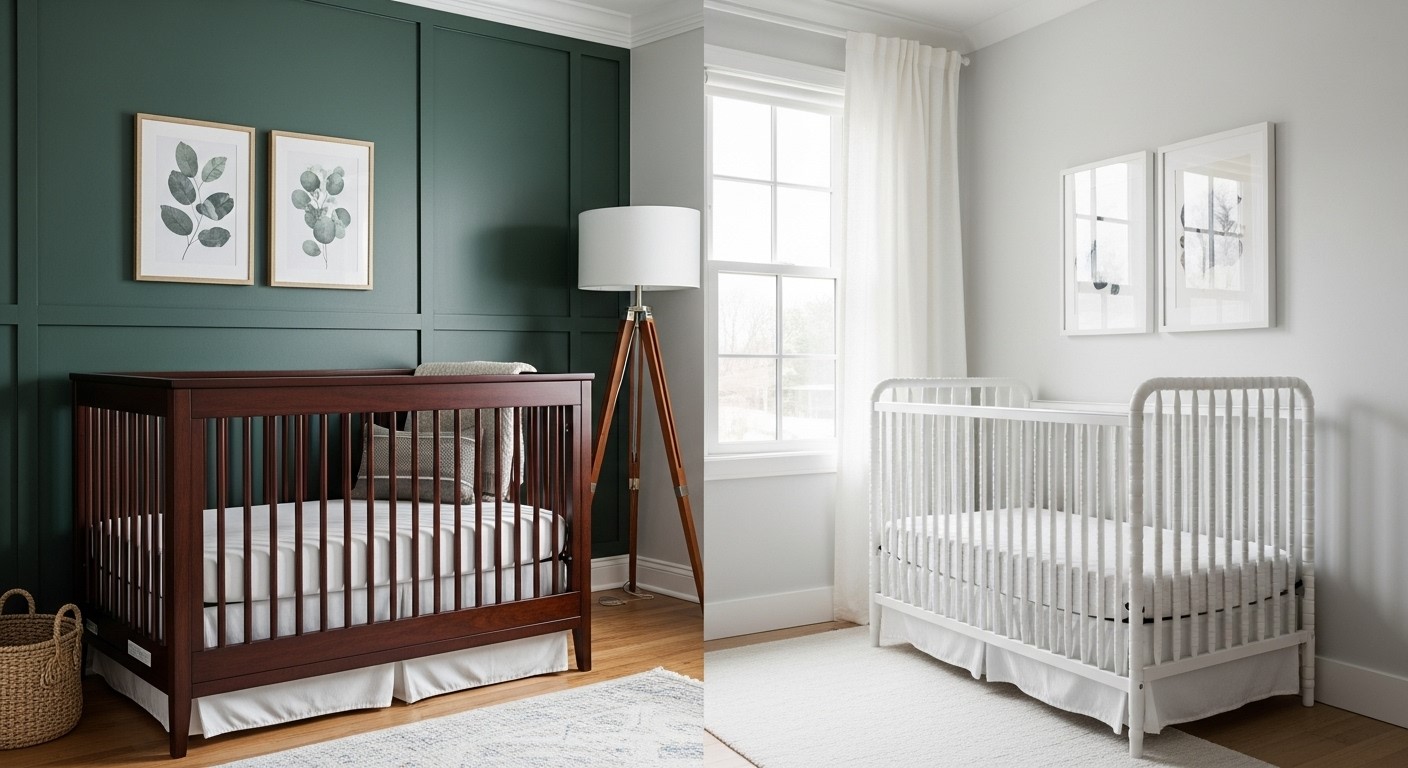Solid Back Crib vs Slats: Why ‘Safer’ is a Myth & What Really Matters
When you’re choosing between a solid back and a slatted crib, you’ve likely seen the common advice that slatted cribs are considered safer.
But here’s the modern reality: thanks to rigorous government safety regulations, that statement is now largely a myth.
Any new crib sold today, whether it has a solid back or slats, must pass the same strict safety tests.
The true deciding factors are no longer about which style is safer, but about visibility, airflow, nursery aesthetics, and long-term functionality.
This guide cuts through the outdated advice to give you the real pros and cons, empowering you to choose the perfect crib based on what actually matters for your family.
Safety First: Why Both Crib Styles Are Safe
Before we dive into the differences, let’s put the biggest parental concern to rest. In the United States, all new cribs sold must meet the stringent safety standards set by the Consumer Product Safety Commission (CPSC).
These standards mandate:
- Slat Spacing: The distance between slats cannot be more than 2 3/8 inches. This is to prevent a baby’s head or body from fitting through.
- Structural Integrity: Cribs undergo rigorous testing to ensure they are durable and won’t fall apart.
- No Drop-Sides: Drop-side cribs, which were linked to numerous infant deaths, are banned.
- Stronger Hardware: All hardware must be durable and cannot come loose easily.
A solid back crib automatically passes the slat spacing test on its back panel, while a slatted crib is specifically designed to meet it.
As long as you are buying a new crib from a reputable brand, both styles are equally safe from a structural and entrapment standpoint.
Quick Comparison: Solid Back vs. Slatted Crib
| Feature | Solid Back Crib | Slatted Crib (All Sides) |
| Aesthetics | Substantial, “furniture” look. Becomes an elegant headboard when converted. | Classic, airy, light, traditional or modern look. |
| Visibility | Poor. Can only see baby clearly from the front or open sides. | Excellent. Can see baby from any angle in the room. |
| Airflow | Reduced. Air doesn’t flow through the solid back panel. | Maximum. Air circulates freely from all four sides. |
| Convertibility | Often a superior choice, as the back panel creates a beautiful headboard. | Converts well, but may retain a “crib” look. |
| Sturdiness | Tends to be heavier and feel very robust and solid. | Very sturdy when assembled correctly. |
| Cleaning | Easy to wipe down the large, flat back surface. | Can be tedious to dust and wipe down each individual slat. |
| Placement | Best placed against a wall to anchor the room. | Versatile. Can be placed against a wall or float in a room. |
| Weight | Significantly heavier and more difficult to move. | Lighter and easier to move for cleaning or rearranging. |
A Detailed Breakdown: What Really Matters
With safety standardized, your choice comes down to these key practical and stylistic differences.
1. Visibility & Peace of Mind
This is arguably the most significant practical difference for new parents.
- Slatted Crib (Winner): The open design provides 360-degree visibility. You can peek in from the doorway, see your baby’s breathing from across the room, and easily position a baby monitor for a clear, unobstructed view. This constant visibility is a huge source of comfort and peace of mind.
- Solid Back Crib: Visibility is limited. If the crib is against a wall (as it’s designed to be), you can only see your baby by standing directly over the front or side rails. This means more trips into the nursery for a visual check and potentially trickier baby monitor placement.
2. Aesthetics & Nursery Style
How do you want the nursery to look and feel?
- Solid Back Crib: This style offers a bold, substantial look. It acts as a statement piece, much like a bed with a headboard, and can anchor the entire room’s design. It exudes a feeling of permanence and high-end furniture.
- Slatted Crib: The classic choice. Slatted cribs are airy and light, which can make a small nursery feel more spacious. Their design is incredibly versatile, fitting everything from traditional to farmhouse to sleek, modern Scandinavian decor.
3. Long-Term Use & Convertibility
Most cribs today are “convertible,” meaning they grow with your child.
- Solid Back Crib (Winner): This is where solid back designs truly shine. When you convert the crib into a toddler bed or a full-size bed, the solid panel becomes a beautiful, seamless headboard. It looks less like a converted crib and more like a purpose-built bed, giving you more value and style in the long run.
- Slatted Crib: These also convert, but the headboard and footboard will both be slatted. While perfectly functional, it can sometimes retain the look of a crib, which may not be the desired aesthetic for a teenager’s room later on.
4. Airflow
While not a formal CPSC safety concern, airflow is on many parents’ minds.
- Slatted Crib: Offers maximum, unrestricted airflow from all four sides. This is a clear advantage for parents who want to ensure the best possible ventilation around their sleeping baby.
- Solid Back Crib: The back panel inherently blocks airflow from that one side. However, with modern safe sleep practices (a firm, flat mattress with no loose bedding, and a well-ventilated room), this is not considered a risk factor.
5. Practicality: Cleaning & Portability
- Cleaning: It’s a trade-off. Wiping down the large, flat surface of a solid back is quick and easy. However, dusting and cleaning dozens of individual slats can be a tedious and time-consuming chore.
- Weight & Moving: Solid back cribs are significantly heavier and more cumbersome. If you anticipate rearranging the room or moving houses, a lighter slatted crib is far more manageable.
The Final Verdict: Which Crib is Right for You?
Forget the outdated safety debate. Make your choice based on your priorities for style, function, and peace of mind.
✅ Choose a Solid Back Crib if:
- You are buying a convertible crib and want a beautiful, seamless headboard for a full-size bed later.
- You love the look of a substantial, statement piece of furniture that anchors the room.
- The crib will be placed against a wall, and you don’t mind sacrificing some visibility for style.
- The idea of wiping down one flat surface instead of 50 individual slats appeals to you.
✅ Choose a Slatted Crib if:
- Maximum visibility is your #1 priority for your own peace of mind.
- You want an airy, classic look that can make a smaller nursery feel more spacious.
- You want the most versatile style that fits nearly any decor.
- You need a lighter crib that is easier to move for cleaning or rearranging.
Ultimately, the best crib is the one that is CPSC-certified, assembled correctly, and fits your family’s unique needs and style. Both a solid back and a slatted crib are excellent, safe foundations for your baby’s nursery.

